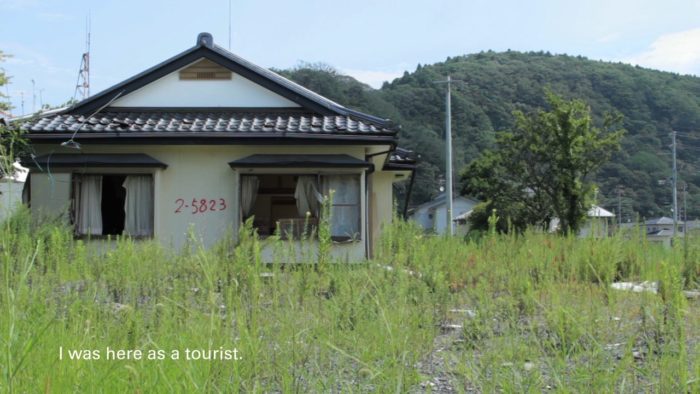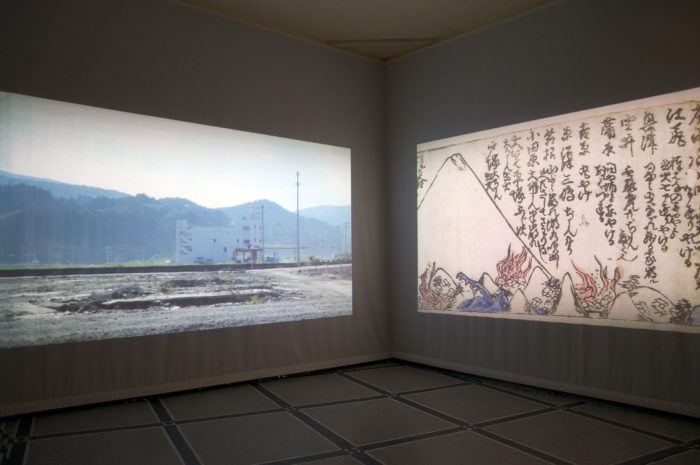“Gravity on earth is, besides of seismic events, especially experienced when collapsing or falling. Or while dancing,” says Nina Wiesnagrotzki over an email chat about her past, present and ongoing projects invested in the research of this physical reality. The Berlin-based Japanese/German artist is currently making new work for a two-person exhibition Alembic Growl with Maximilian Schmoetzer (and curated by Florian Fischer) at Brussels’ Komplot opening November 16.

Currently researching notions of gravity and seismic movements, as well as the supernatural and mythology, the pair will each show a new video as well as individual sculptural elements to accompany the large-scale collaborative piece.
Splitting her time between the profession of artist and medical doctor, Wiesnagrotzki’s research and practice is placed within the space of intersection; between “mythology and technology, the concept of East and West, the human body and the machine.” Her current projects stem from her ongoing research around earthquakes, following on from video-documentary ‘Sansui, Landscape’ (2014) which looked at the Fukushima powerplant tsunami catastrophe of 2011. Meanings of mountains, origin, and disaster are woven into a collaged storyline.
In a conversation about current and other recent projects at i:project space and Chinese Seismic Investigations, the artist brings us behind the scenes of her current research into foundation that moves between ‘conceptually related characters,’ like the Chinese Dragon, the human vestibular organ and the drone.
** A lot of your work seems very concerned with issues of climate change — is it climate change in particular you are thinking about, or are you more drawn to the subject matter of what feels incomprehensible and out of bounds?
Nina Wiesnagrotzki: Climate change or global warming was made visible with the Hockeystick Diagram by Michael E. Mann in 1999. Its name derives from the visually striking resemblance of the graph’s shape to a hockeystick. The diagram shows a relatively constant temperature profile over the last 1000 years and increases significantly from the 20th century to the present. It was controversially discussed, particularly among climate change sceptics. Despite of the graph’s widespread approval, some people still relate to climate solely as changing weather conditions, like I got to know during the US election campaign.
I am interested in a transition from objective facts as embodied in natural sciences into something else, like for example the still disputed human’s impact on climate or an increasing frequency of natural disasters.

My current project can be seen as a continuation of my last experimental documentary Sansui, Landscape, which is based on the earthquake in 2011 that caused the tsunami and in its aftermath the disaster at the nuclear power plant in Fukushima. I collaged different significations of mountains in Japan with my own German origin. Being half-Japanese, I grew up in the foothills of the Alps.
** There’s a lot of movement with your work, whether it’s disorientation, or a feeling of instability or of not being able to process the image in front of you before its already changed.
NW: I’m currently working around the notion of the physical virtue of gravity on objects and humans. It was instigated by my interest in the first seismic device that was supposed to be invented in China around 100AD. Actually, it never worked. The project’s first two instances were on display at i:project space (Beijing, Oct 2016) and at Chinese Seismic Investigations (Berlin, March 2017).
One trail I am taking up at the moment is sensory mismatch. Unless we are talking about seismic events, gravity on earth is especially experienced when collapsing or falling. Or while dancing. Sensory mismatch of the vestibular system, the visual and the joint sense (proprioception) can cause vestibular dysfunction, an illusion of movement of the self or the environment. It can be associated with a nystagmus, also called “dancing eyes”, which signifies involuntary eye movements. A physiological nystagmus can be initiated through cold or warm water in one ear in the course of a caloric test.
Similar to what Simone Weil writes in Gravity and Grace, “would a society in which only gravity reigned be able to exist, or is a little of the supernatural element a vital necessity?” I am revolving around binaries like mythology/technology, cultural East/West and the human body/machine. These interests are certainly tinted by my medical studies – I am working in a hospital as a doctor.

** Could you tell us about your interest and use of absurdity?
NW: Absurdity can be a great connector between my divergent research, but I don’t rely on it or think about it during working. With regard to my project, one venue I’m pursuing is a morphed 3D animated object consisting of three formally related characters: the Chinese Dragon as a proxy for eastern mythology and science, the human vestibular organ (= labyrinth) and a drone as an agent of science-fictional ideas that beats gravity on earth through technology. The suspension of the laws of physics or to be more precise in this case the gravitation’s pull has an absurd dimension to it.
NW: To stick with the just mentioned sensory mismatch: a person who was suffering from an upbeat nystagmus as a result of a malign tumor, was implanted two magnets in his eyes in order to fixate on objects again. The magnet was pinned on a muscle on the bottom part of the eye and the mural of the eyeball. This was the first operation of its kind. These rare-earth magnets, are strong enough so that he could read, watch television, and even work again. The operation was conducted 4 years ago and reportedly his state of health is stable.
I don’t think it is about optimism, but about how this relationship develops. And about how we gain a more intricate perception of our increasingly, technologically augmented society.**















